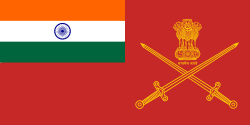Cold Start Doctrine
|
Indian Army भारतीय थलसेना |
|
|---|---|
|
Flag of the Indian Army
|
|
| Founded | 1 April 1985 |
| Country | India |
| Type | Army |
| Size | 1,325,000 active personnel 960,000 reserve personnel & 104 aircraft |
| Part of | Indian Armed Forces |
| Headquarters | DHQ Zone |
| Motto(s) | "Service Before Self" |
| Colours | Gold, red and black |
| Website | Official Website of the Indian Army |
| Commanders | |
| Chief of the Army Staff (COAS) | General Bipin Rawat |
| Vice Chief of the Army Staff (VCOAS) | Lt Gen MMS Rai |
| Notable commanders |
Field Marshal K M Cariappa Field Marshal Sam Manekshaw General K S Thimayya |
| Aircraft flown | |
| Helicopter | HAL Rudra, Mi17, Mi8 |
| Transport | HAL Dhruv, HAL Chetak, HAL Cheetah and Cheetal |
Cold Start is a military doctrine developed by the Indian Armed Forces for use in a possible war with Pakistan. It involves the various branches of India's military conducting offensive operations as part of unified battle groups. The Cold Start doctrine is intended to allow India's conventional forces to perform holding attacks in order to prevent a nuclear retaliation from Pakistan in case of a conflict.
India's defence strategy from 1974 was, in the words of former defence minister George Fernandes, “a non-aggressive, non-provocative defense policy,” centred around "holding corps" to halt hostile advances. In response to the terrorist attack on the Indian Parliament in 2001, India initiated a full mobilisation. Taking almost a month, the slow mobilisation demonstrated the weakness of India's then current policy. The long mobilisation time resulted in sufficient international pressure preventing India from conducting a retaliatory strike.
The Sundarji Doctrine was made up of seven defensive "holding corps" of the Indian Army and deployed near the Pakistani border. Possessing limited offensive power, the holding corps' primary responsibility was to check a Pakistani advance. India's offensive potency was derived from the "strike corps," which were made up of a mechanised infantry and extensive artillery support. "Unlike the holding corps that was deployed close to the border," argues Walter Ladwig of the University of Oxford, "the strike corps was based in central India, a significant distance from the international border. In a war, after the holding corps halted a Pakistani attack, the strike corps would counterattack, penetrating deep into Pakistani territory to destroy the Pakistan Army's own strike corps through 'deep sledgehammer blows' in a high-intensity battle of attrition."
However, the limitation of the Sundarji doctrine was exposed on 13 December 2001, when five masked men attacked the Indian Parliament. Twelve people—including the five gunmen—were killed and 22 were injured. India suspected Kashmir based militant groups were behind this because just two months earlier, a similar assault was carried out by the Jaish-e-Mohammad on the Kashmir state assembly. India received credible evidence that Pakistani-sponsored militant groups Lashkar-e-Taiba and Jaish-e-Mohammad were behind the attack, prompting India to initiate Operation Parakram, the largest activation of its forces since the 1971 Bangladesh war.
...
Wikipedia

